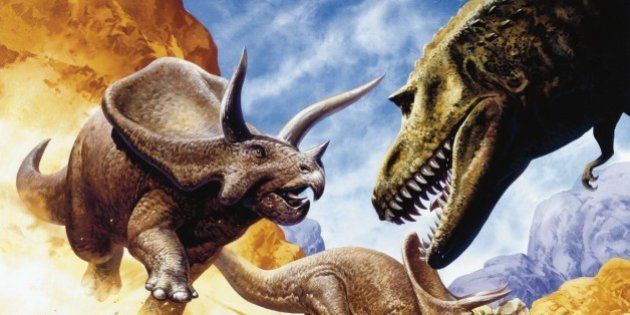
LONDON -- Scientists have uncovered the rare fossil of a dog-sized horned dinosaur in eastern North America that roamed the Earth up to 100 million years ago.
The fossil, identified by Dr Nick Longrich from the University of Bath in UK, provides evidence of an east-west divide in North American dinosaur evolution.
During the Late Cretaceous period, 66-100 million years ago, the land mass that is now North America was split in two continents by a shallow sea, the Western Interior Seaway, which ran from the Gulf of Mexico to the Arctic Ocean.
Dinosaurs living in the western continent, called Laramidia, were similar to those found in Asia.
However, few fossils of animals from the eastern 'lost continent' of Appalachia have been found because these areas are densely vegetated, making it difficult to discover and excavate fossils.
Longrich studied one of these rare fossils, a fragment of a jaw bone kept in the Peabody Museum at Yale University in US. It turned out to be a member of the horned dinosaurs - the Ceratopsia.
His study highlights it as the first fossil from a ceratopsian dinosaur identified from this period of eastern North America.
Ceratopsia is a group of plant-eating horned dinosaurs that lived in the Cretaceous period. The fossil in question comes from a smaller cousin of the better known Triceratops, the leptoceratopsids. It was about the size of a large dog.
The specimen studied by Longrich was too incomplete to identify the exact species accurately, but showed a strange twist to the jaw, causing the teeth to curve downward and outwards in a beak shape.
The jaw was also more slender than that of Ceratopsia found in western North America, suggesting that these dinosaurs had a different diet to their western relatives, and had evolved along a distinct evolutionary path.
"Just as many animals and plants found in Australia today are quite different to those found in other parts of the world, it seems that animals in the eastern part of North America in the Late Cretaceous period evolved in a completely different way to those found in the western part of what is now North America due to a long period of isolation," said Longrich.
"This adds to the theory that these two land masses were separated by a stretch of water, stopping animals from moving between them, causing the animals in Appalachia to evolve in a completely different direction, resulting in some pretty weird looking dinosaurs," said Longrich.
"Studying fossils from this period, when the sea levels were very high and the landmasses across the Earth were very fragmented, is like looking at several independent experiments in dinosaur evolution," he said.
The study was published in the journal Cretaceous Research.



Contact HuffPost India
Also see on HuffPost:
